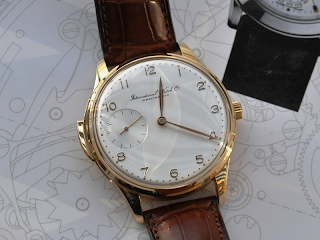Most People who collect watches tend to acquire timepieces with few if any complications, maybe a date function or a chronograph, don’t they? Possibly, once they go higher end, a perpetual calendar.
How often do you see a Minute repeater on someone’s wrist? I think most of us think Patek Philippe when talking about a Minute repeating wristwatch, don’t we? Nevertheless, there are Minute repeaters made by other watchmanufactures. One of them is IWC.
This is a pretty rare IWC 5240-05 Portugieser Minute Repeater in rose Gold. It still is the original version based on caliber 952. Caliber 952 has a bridge layout and the small second at 9 o’clock. The dial is similar to the Jubilee Portugieser watch with thread-writing.
The IWC Portugieser Minute repeater is the only IWC Repeater with own movement in a classic look. Sized at 42mm width times 11mm height it is less obvious than a tourbillon which is technically interesting but quite useless on a wristwatch. Originally Tourbillons were designed for pocketwatches which are in one Position only and not changing their Position constantly. Wearing this Minute repeater most likely will not generate much Attention, for some people this is viewed as an Advantage. However, you can easily wear this repeater on a daily basis although it is not waterresistant and you should be careful in that regards.
One Thing I have to say is that this watch truly has ist own simple Beauty.
The movement with Geneva stripes matches the large case size well, and is nice to look at.
Above you see the Position of the small seconds at 9 o’clock which is due to the caliber 9x based on a pocketwatch caliber 952, the second generation of the flat bridge caliber 95.
The main difference to the first Version is the added shock protection and the additional two jewels (19 instead of 17). The power reserve in the regular movement is 36 hours while the Minute repeater movement runs for 43 hours. In fact, it runs even longer. Additionally, there is a stopp-seconds mechanism.
The movement is quite unusual for a wristwatch, because it is basically a Lepine movement usually used in a pocketwatch. The seconds indication is on the opposite side of the crown.
You can see an example below in the pocketwatch: (Ref. 5205)
Why didn’t IWC use a Savonette movement where the crown and small seconds are positioned in 90 degrees to eachother, similar to the caliber 982 used in the Jubilee Portugieser reference 5441?
Well, the answer is simply based on the height of the case. Bridge movements have three Levels of height: H5 (caliber 67) with appx. 5mm, H4 (cal. 97 and 98) with appx. 4mm und H3 with 3mm.
The H3 movement is a Lepine-movement. The Minute repeater module has to be added to the base movement. While the size is 42mm times 12.3mm, the actual Version of the Minute repeater now has the small seconds at 9 o’clock and presents in a Savonnette-Layout – which led to an increase in size of 44mm x 14 mm, a noticeable difference on your wrist.
The movement of the reference 5240 carries caliber number 95290 and is based on the “original” movement production at IWC.
This raw movement is not available any more nowadays.
The design of the movement on reference 5240 is still classic and without pretention which I really prefer. Old School at its best. Obviously, there is still Manual labour involved in this movement.
Die finishing is classic with Geneva stripes, polished angles, perlage and Gold chatons, a true Balance wheel, all signs of real manufacture work.
The Minute Repeater:
Historically, Minute repeaters exist already for hundreds of years. IN the early days, they were found in clocks in churches, by day and night, chimes were indicating the time.
Generally, there are two kinds of repeating movements. mechanisms which indicate time on a constant Basis and without help, they are called “sonnerie”, they can either indicate the hour, or the quarter hour in the “grande sonnerie”.
Repeaters indicate time only after activating the chiming by a sliding valve usually located on the left side of the watch. There are several variants as to the indication of time, including quarter hours, 5-minute Intervalls, or the Minute repeater which is the highest grade complication of all of them.
´The base function as used today is derived from “Breguet” himself.
While I could continue with an Elaborate Explanation on how the Minute repeater works, I will let Pictures speak:
All Pictures and Information courtesy of a fellow collector.






























